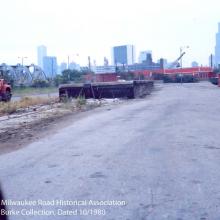25 Hits for December 2017
Albums (0) & Images (25)
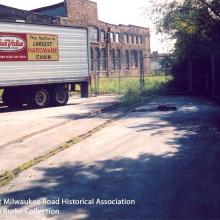
tb_mrha_deeringline_09_1980_06.25
We’re in the depths of the Cotter & Company complex now that occupied most of the former IH Deering Works buildings. Note the True Value trailers stored here. See the accompanying map for details on the location of these spurs.tb_mrha_deeringline_09_1980_06.25
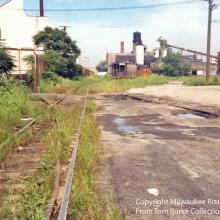
tb_mrha_deeringline_09_1980_08
Technically we are looking northwest along the C&E North Line on Kingsbury Street but this photo also shows the start of the Deering Line ahead in the distance. Note the caboose and covered hopper in the distance. Presumably the hopper is for Reed Candy, Continental Baking, or Peerless Confectionary farther up the C&E North Line.Just to the left of the hopper is the junction point between the C&E and Deering Lines. My guess is that a crew is working the Deering Line at this moment and left the rest of the train on the start of the C&E Line.
Note how Kingsbury Street was paved in dirt in 1980. That’s Finkl Steel to the left with one of its two spurs entering the property. This spur is still visible inside their fence in 2010 though no longer connected to the outside world since it was sliced off in 1985. This view looks northwest from about Cortland Avenue. In 1985 the City of Chicago would repave this section of Kingsbury and new trackage would set in concrete in the middle of the street with asphalt around the sides.
tb_mrha_deeringline_09_1980_08
Just to the left of the hopper is the junction point between the C&E and Deering Lines. My guess is that a crew is working the Deering Line at this moment and left the rest of the train on the start of the C&E Line.
Note how Kingsbury Street was paved in dirt in 1980. That’s Finkl Steel to the left with one of its two spurs entering the property. This spur is still visible inside their fence in 2010 though no longer connected to the outside world since it was sliced off in 1985. This view looks northwest from about Cortland Avenue. In 1985 the City of Chicago would repave this section of Kingsbury and new trackage would set in concrete in the middle of the street with asphalt around the sides.
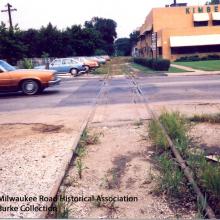
tb_mrha_dunningline_09_1980_01
This view looks north at the Kimbell Candy Company on Belmont Avenue. The Milwaukee Road’s Dunning Line is to the left or west. Kimbell Candy was the northernmost rail-served industry on this line by 1980. It once reached across Irving Park Road to the north to service the Chicago State Hospital.tb_mrha_dunningline_09_1980_01
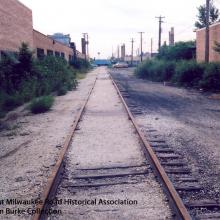
tb_mrha_dunningline_09_1980_02
The Milwaukee Road photographer is looking south from George Street along the Dunning Line towards Diversey Avenue in the distance. A 1982 study by the railroad suggested discontinuing service to Kimbell Candy due to low traffic and cutting service back to just south of George Street. Enough room would be left via a “tail track” for trains to back freight cars into the Chicago Steel Rule spur just past Diversey. A condo complex was built in this area in 2006 and the tail track remainder of the Dunning Line north of Diversey was preserved in its parking lot-but it was not to be used again.tb_mrha_dunningline_09_1980_02
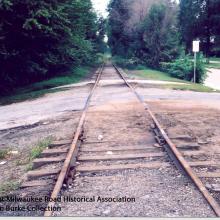
tb_mrha_dunningline_09_1980_03
This view looks north across the George Street grade crossing. The same internal report stated that teenage drivers would often get airborne with their cars at this crossing, creating a potential liability issue for the railroad and another reason to abandon the line from this grade crossing north. Ahead is Kimbell Candy.tb_mrha_dunningline_09_1980_03
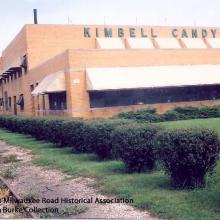
tb_mrha_dunningline_09_1980_04
Another view of Kimbell Candy with its spur alongside the property, just past the line of shrubs.tb_mrha_dunningline_09_1980_04
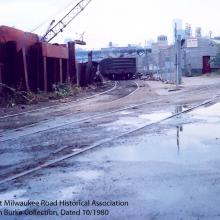
tb_mrha_gooseisland_10_1980_01
This photo shows a gondola on a spur that came off Hooker Street south of Division Street. According to a 1971 Milwaukee Road engineering diagram the customer at this location was the Glendale Coal & Material Company though by 1980 the site may have changed hands and become a scrapyard. This view looks southeast toward the now gone Ogden Avenue overpass.tb_mrha_gooseisland_10_1980_01
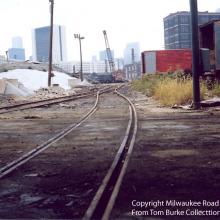
tb_mrha_gooseisland_10_1980_02
We’re looking southeast across the intersection of Haines and Hickory on the southern end of Goose Island. Ahead is another scrapyard though the 1971 Milwaukee Road engineering diagram shows that the Ozite Corporation was located there. Note the puzzle switch ahead which could go direct trains in multiple directions. The track to the right past the puzzle switch crossed North Branch and connected to the track that ran along North Branch. This track was valuable as another way back to the yard if freight cars were blocking the way back along parallel Hickory. The track in the foreground went into the former Wieboldt’s warehouse, now used by Pickens-Kane. Wiebold’s was a Chicago department store chain which went out of business in the late 1980s.tb_mrha_gooseisland_10_1980_02
